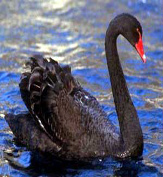Non-Flying Birds | Birds of Prey | Extinct Birds | Waterfowl Common name: Black Swan Scientific name: Cygnus atratus Family: Anatidae Description In adult Black Swans the body is mostly black, with the exception of the broad white wing tips which are visible in flight. The bill is a deep orange-red, paler at the tip, with a distinct narrow white band towards the end. Younger birds are much greyer in colour, and have black wing tips. Adult females are smaller than the males. Distribution Black Swans are found throughout Australia with the exception of Cape York Peninsula, and are more common in the south. The Black Swan has been introduced into several countries, including New Zealand, where it is now common, and is a vagrant to New Guinea. Habitat Black Swans prefer larger salt, brackish or fresh waterways and permanent wetlands, requiring 40 m or more of clear water to take off. Outside the breeding season, Black Swans travel quite large distances. Birds fly at night and rest during the day with other swans. Feeding The Black Swan is a vegetarian. Food consists of algae and weeds, which the bird obtains by plunging its long neck into water up to 1 m deep. Occasionally birds will graze on land, but they are clumsy walkers.
|
|
Wood Duck Family: Geese
Description: Male wood ducks have a crested head that is iridescent green and purple with a white stripe leading from the eye to the end of the crest and another, narrower white stripe from the base of the bill to the tip of the crest. The throat is white and the chest is burgundy with white flecks, gradually grading into a white belly. The bill is brightly patterned black, white, and red. The legs and feet are dull straw-yellow, and the iris is red. Female wood ducks have a gray-brown head and neck with a brownish, green glossed crest. A white teardrop shaped patch surrounds the brownish-black eye. The throat is white and the breast is gray-brown stippled with white fading into the white belly. The back is olive-brown with a shimmer of iridescent green. The bill is blue-gray and the legs and feet are dull grayish-yellow.
A distinctively North American duck specie, wood ducks inhabit areas from southern Canada to the eastern, southern and western coasts of the United States – in swamps, creeks, river valleys, streams, lakes and forest bottomlands. Habitat Found in forested wetlands, including along rivers, swamps, marshes, ponds, and lakes.
The Wood Duck Feeding Preferences Wood ducks are mainly vegetarian, feeding on aquatic plants, seeds and fruits although ducklings may feed on small insects or fish, the protein being necessary for their growth.
|
Common Name: Canada Goose Scientific Name: Branta canadensis Family: Geese and Ducks (Anatidae) Description - Male: Canada Geese are large birds, 20 to 50 inches long with a wingspan of 50-68 inches. Canada Geese are most easily identified by their long black neck, with a black head, crown and bill. They have a contrasting white cheek and throat area. Their undertail coverts are white. Their back, upper wings and flank are dark brown with a lighter brown (sometimes, nearly white) breast and belly. They have a short black tail and black legs with black webbed feet. Habitat: Canada Geese live around ponds, river and lake shores. They've become quite a common sight in city parks -- some cities are having trouble with overpopulation of the geese and, for this reason, are trying to discourage people from feeding them in the overpopulated areas. Habitat: Canada Geese live around ponds, river and lake shores. They've become quite a common sight in city parks -- some cities are having trouble with overpopulation of the geese and, for this reason, are trying to discourage people from feeding them in the overpopulated areas. Food Entirely herbivorous. Eats variety of plant species and parts, especially grasses, sedges, grain, and berries.
Non-Flying Birds | Birds of Prey | Extinct Birds | Waterfowl |



.jpg)